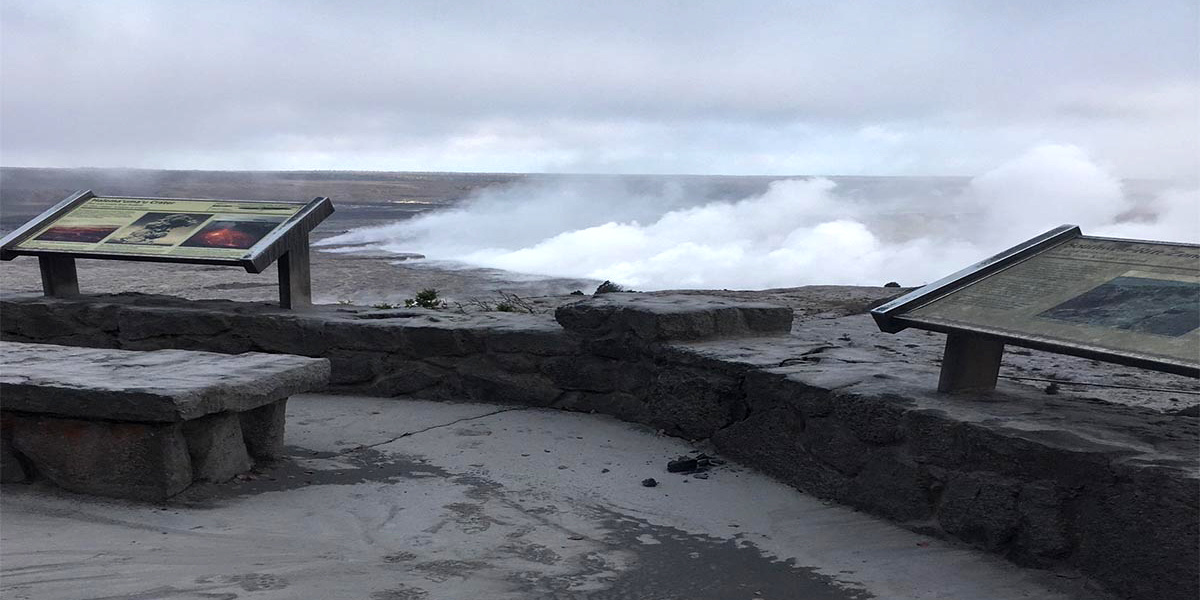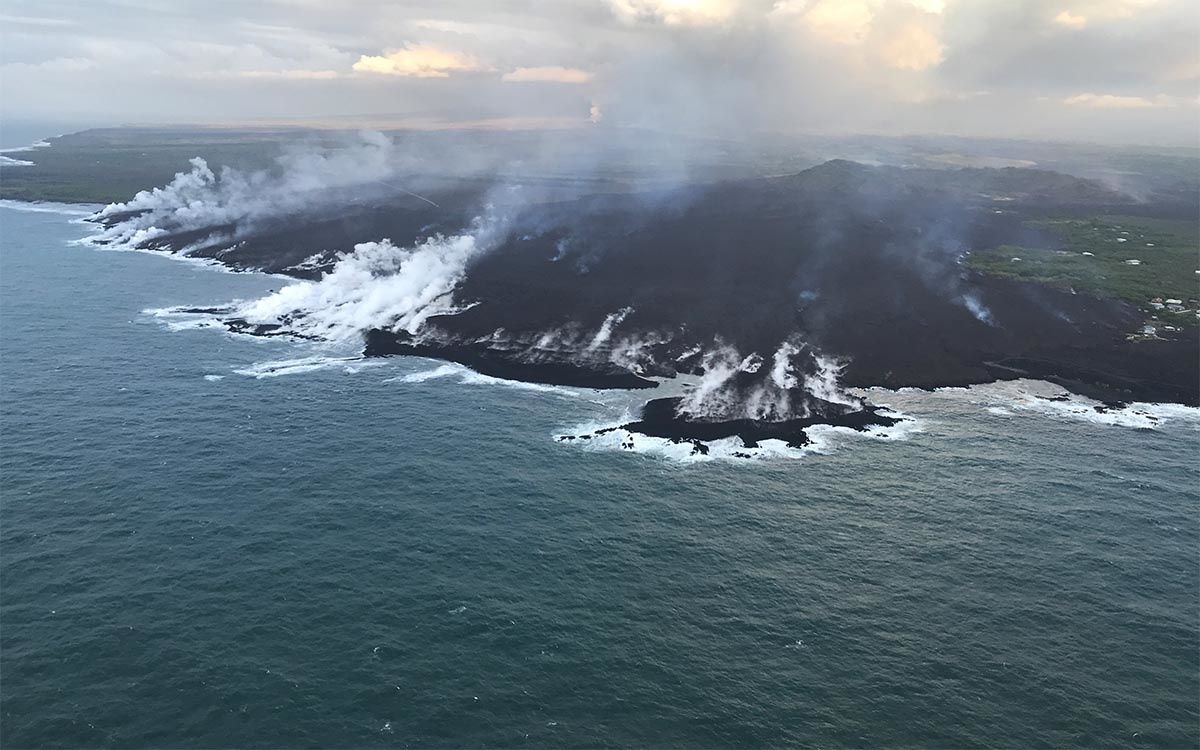

Ash covers the observation deck of the Jagger Museum, showing a cracked floor. National Park Service
By Dan Zukowski
When searing black lava from fissure 8 slid into the Pacific Ocean at Kapoho Bay on June 3, it had been five weeks since the collapse of the Pu’u ‘Ō’ō crater, along the eastern rift zone of the Kīlauea volcano on Hawaii’s Big Island. Toxic, acid-laden steam billowed high above boiling waves. Within 36 hours, the bay became paved over by lava, creating a new coastline almost a mile out and destroying shallow-water coral reefs and tidepools.
“It’s been an absolute loss,” said marine biologist Misaki Takabayashi of the University of Hawaii at Hilo. The area was popular with snorkelers for its easy access and intense beauty. Takabayashi described the view as floating above a colorful coral reef set against stark black basalt. “When people would go, they were in awe,” she told me.
The name Kapoho derives from the Hawaiian word poho, meaning a depression or hollow. Those dips in the seafloor created the Wai’ōpae Tidepools, part of which were protected by the state as a Marine Life Conservation District. Takabayashi’s team had been studying those for 12 years. They are now gone as well.
Pu’u ‘Ō’ō, 2,300 feet up on Kīlauea, has been erupting continuously since 1983, delighting tourists and repeatedly inundating landscapes and communities downstream with destructive lava flows. The current event has been associated with some 12,000 earthquakes, the largest a 6.9-magnitude shaker on May 4. More than 20 separate fissures in the Earth have opened.
Kīlauea is the prime attraction of Hawaii Volcanoes National Park, a UNESCO World Heritage Site that saw more than 2 million visitors last year. Now, most of the park is closed indefinitely.
Park roads are cracked and covered with ash from eruptions that have shot up 10,000-foot-high plumes. The Hawaii Volcano Observatory, Jagger Museum and emergency operations center have all experienced considerable earthquake damage. The entire park is without running water.
It’s too dangerous near the crater for park staff to go out and monitor the impacts on wildlife and native plants. Rhonda Loh, chief of natural resources management for Hawaii Volcanoes National Park, responded to my questions by email. “There’s potential for impact to all birds from ash and volcanic gases. Respiratory issues are a concern, as are impacts to food resources from ash.”
Among the worries is the endangered nēnē, also known as the Hawaiian goose, the official state bird. Hawaiian honeycreeper birds, rare Ka’ū silversword plants, and native ‘ōhi’a and koa forests may also be at risk. Nesting season for the nēnē has passed, so they may have moved away from the ash plume, Loh said.
Another concern are the indigenous white-tailed tropicbirds (koa’ekea), which nest in the crater walls at Halema’uma’u. “On May 25, as many as 25 koa’ekea were counted flying around the billowing gray ash cloud at Halema’uma’u following large ash explosions triggered by a shallow magnitude 4.0 earthquake,” Loh said. Spring being mating and nesting season, these birds could still be parenting their eggs and chicks. “But it’s hard to say for certain,” she added.
Outside the national park, habitat destruction has come from ashfall, lava flows, and wildfires sparked by burning lava.
Green Lake, a 400-year-old freshwater lake in Kapoho, evaporated in just a few hours on June 2. “That was a very nice lowland, freshwater pool area, so it undoubtedly was housing some native species,” said David Smith, an administrator with the Hawaii Department of Land and Natural Resources. “The lava just poured straight into it and filled it up.”
The path of destruction continued into the 1,514-acre Malama Kī Forest Reserve. As much as two-thirds of the reserve has been hit by lava flows and fires. “It was a fairly unique lowland native forest,” Smith explained.
Lava fountains erupt from fissure 8, sending a river of molten rock seven miles down to the ocean. U.S. Geological Survey
A June 6 explosion within the Halema’uma’u crater sent ash and gas 10,000 feet above sea level. U.S. Geological Survey
Laze plumes rise from the lava delta that has formed over Kapoho Bay. U.S. Geological Survey
The Hawaii ‘amakihi and ‘apapane, two species of honeycreepers, called the forest home. Although neither are endangered species, these lowland populations possessed an unusual ability to resist avian malaria and avian pox, diseases spread by nonnative mosquitoes. Upland populations of these same birds often succumb. A press release from the natural resources department stated that these disease-resistant subpopulations “may no longer persist, rapidly decline, or become further fragmented and/or contract in range.”
The eruption came with risks to human health and property as well. More than 600 homes have been lost, making this latest event Hawaii’s most destructive in modern times. Communities have been wiped out and others severely damaged. The towering gray plumes rising from the volcano contain sulfur dioxide. When it reacts with sunlight, oxygen and water, it creates vog, which can cause respiratory problems.
Laze (lava haze) forms when molten lava meets seawater, as in Kapoho Bay. The reaction creates hydrochloric acid and tiny slivers of volcanic glass, which is present in the steam columns rising from the water. Laze can irritate skin and eyes and cause breathing difficulties.
The leading edge of the lava flow in the ocean is now nearly a mile wide, said the U.S. Geological Survey in a June 8 media call. It was a habitat for Hawaiian green sea turtles, a genetically distinct species. Hawaii News Now reporter Mileka Lincoln reported seeing dead fish and sea turtles floating on the water on June 6.
Many Hawaiians see the hand of Madame Pele, the goddess of fire and volcanoes, at work. It is “she who shapes the sacred land.” And, as David Smith reminded me, “It seems harsh, but it’s part of a continual renewal process. It’s how the Hawaiian Islands are formed.”
No one knows how long this eruption will last. When it does calm down, officials from Hawaii’s natural resources department, scientists from the National Park Service, and researchers from the University of Hawaii will get to work evaluating the changes wrought by Madame Pele.
Speaking of what was once Kapoho Bay, Misaki Takabayashi told me, “The land is brand-new, and there will be another coral reef soon enough.” Still, she looks at the role humans will play in this. “We are very much a part of the landscape, and we have responsibilities to take care of the next coral reef that’s going to sprout out of this.”
Reposted with permission from our media associate SIERRA Magazine.

 233k
233k  41k
41k  Subscribe
Subscribe 


